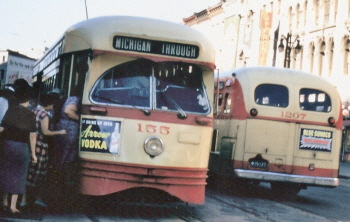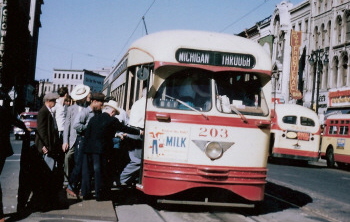| . |
(to be continued in Part 5, "The End of an Era in Detroit -- The Mexico City Sale".... (coming later!))
DETROIT PCC SERIES: 1 2 3 4 5
DETROIT PCC SERIES: 1 2 3 4 5
| . |
| . |
| . |
| For Comments & Suggestions Please Contact Site Owner at: admin@detroittransithistory.info |
| THE P.C.C. ERA IN DETROIT – Part 4 (The Battle for Flexibility and Safety versus Fixed Rail) |
| Click here to return to "THE PCC ERA IN DETROIT" Main Page. |
| For additional information and photos on the streetcar era in Detroit see the publication "Images of Rail - DETROIT'S STREET RAILWAYS" authored by Kenneth Schramm (Arcadia Publishing) |
| (Thomas C. Van Degrift photo, from Central Electric Railfans' Association, Bulletin #120) |
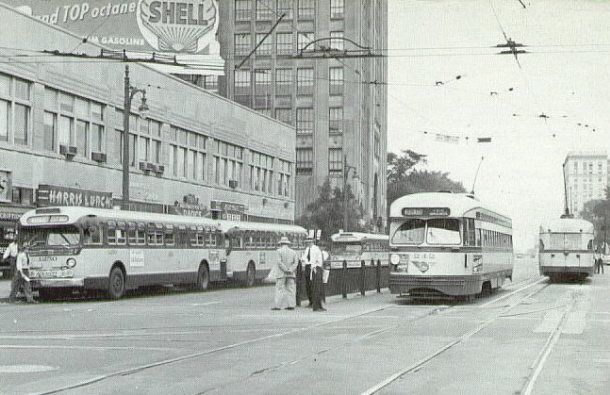
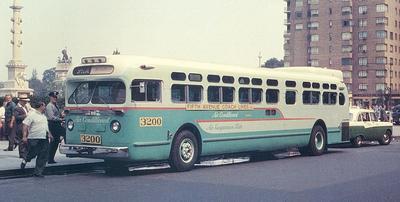
| The above August 1956 photo shows GM demonstrator coach #3200 while being tested by Fifth Avenue Coach Lines of NYC. Before it was converted into this "air-suspension" model TDH-5105 (serial EXP-305) --with air-conditioning added in 1956--it was originally built in 1950 as GM demo TDH-5103 (serial #0001). It was during its original days as a model TDH-5103 when it was tested by the DSR during August 1951. (NYC Subway Web News Photo) |
By the end of 1950, a fleet of 186 PCC streetcars were operating along the streets of Detroit, providing service for the
city's last remaining rail lines: WOODWARD, JEFFERSON and MICHIGAN-GRATIOT. Although the DSR was now
operating with a fleet of the most modern, streamlined, high performance streetcars of that day, a series of events
would take place which would begin to change the transit picture in Detroit for many decades to come.
city's last remaining rail lines: WOODWARD, JEFFERSON and MICHIGAN-GRATIOT. Although the DSR was now
operating with a fleet of the most modern, streamlined, high performance streetcars of that day, a series of events
would take place which would begin to change the transit picture in Detroit for many decades to come.
In 1950, GM Truck & Coach introduced its 40-foot
long, 102-inch wide, 51-passenger, "large capacity"
diesel-powered transit coach, the model TDH-5103.
Prior to its introduction, most transit coaches of that
day were gasoline-powered, and seated less than
45 passengers. GM would promote these new
"king-size" buses as the alternative to the PCC car.
In July of 1950, the Engineering Division of
General Motors developed demonstrator coach
TDH-5103 (serial #0001). This GM demo would
later arrive in Detroit for testing with the DSR on
Aug. 13, 1951. The GMC demonstrator (numbered
as coach #300) was tested by the DSR for 3,929
miles and returned to GM on Aug. 31, 1951.
After reviewing the GM demonstrator, Leo Nowicki
(DSR general manager) was obviously impressed
with these buses. Nowicki became convinced that
long, 102-inch wide, 51-passenger, "large capacity"
diesel-powered transit coach, the model TDH-5103.
Prior to its introduction, most transit coaches of that
day were gasoline-powered, and seated less than
45 passengers. GM would promote these new
"king-size" buses as the alternative to the PCC car.
In July of 1950, the Engineering Division of
General Motors developed demonstrator coach
TDH-5103 (serial #0001). This GM demo would
later arrive in Detroit for testing with the DSR on
Aug. 13, 1951. The GMC demonstrator (numbered
as coach #300) was tested by the DSR for 3,929
miles and returned to GM on Aug. 31, 1951.
After reviewing the GM demonstrator, Leo Nowicki
(DSR general manager) was obviously impressed
with these buses. Nowicki became convinced that
GM diesels should evetually replace everything on the property. Earlier that year Nowicki commissioned GM Truck &
Coach to conduct a study to determine how many large GM buses would be needed to handle the DSR's major routes.
The ensuing GM Report would have a major impact on the future of Detroit transportation. It was released in 1951 by
the Transportation Survey Department of the General Motors Corporation, Truck and Coach Division.
The GM Report recommended that prime consideration be given for the acquisition of 148 "large-capacity" (51-pass.)
GM diesel buses for the conversion of five streetcar lines: Trumbull, Mack, Clairmount, Oakland, and Mt. Elliott. It
also recommended the purchase of an additional 250 of these buses to replace the existing 650 "small-size" bus fleet.
Little did Detroiters realize then, but the eventual transit domination by General Motors was right around the corner.
Another event which would help play a contributing role in the change of the city's transit picture was the two month
long transit strike against the DSR by the operating employees of Division 26 of the Amalgamated Association of
Street, Electric Railway and Motor Coach Employees of America. The 59-day strike (from April 21 thru June 19,
1951) helped set the stage for the conversion of five of the six remaining Peter Witt car lines. After being forced back
to work under the Hutchinson Act, many streetcar crews returned to discover that their lines had been converted to
buses and their jobs eliminated. The ongoing post-WW-II sharp ridership decline — now made worse by the strike —
also made enough coaches available to replace streetcars on the same five lines later suggested in the GM Report.
Following the end of the 59-day transit strike, the DSR discontinued streetcar service on five rail lines. Between June
19, and Nov. 11, 1951, the Mt. Elliott, Oakland, Trumbull, Clairmount, and Mack lines were converted to buses.
With only the Baker and the PCC lines now left operating, the Jefferson Carhouse (Jefferson at St. Jean) closed on
Sept. 5, 1951, resulting in the Jefferson PCC cars being transferred to the Gratiot Carhouse (Gratiot at Harper).
These cars now had to deadhead along the rails of the now abandoned Clairmount line to access Jefferson Avenue.
Coach to conduct a study to determine how many large GM buses would be needed to handle the DSR's major routes.
The ensuing GM Report would have a major impact on the future of Detroit transportation. It was released in 1951 by
the Transportation Survey Department of the General Motors Corporation, Truck and Coach Division.
The GM Report recommended that prime consideration be given for the acquisition of 148 "large-capacity" (51-pass.)
GM diesel buses for the conversion of five streetcar lines: Trumbull, Mack, Clairmount, Oakland, and Mt. Elliott. It
also recommended the purchase of an additional 250 of these buses to replace the existing 650 "small-size" bus fleet.
Little did Detroiters realize then, but the eventual transit domination by General Motors was right around the corner.
Another event which would help play a contributing role in the change of the city's transit picture was the two month
long transit strike against the DSR by the operating employees of Division 26 of the Amalgamated Association of
Street, Electric Railway and Motor Coach Employees of America. The 59-day strike (from April 21 thru June 19,
1951) helped set the stage for the conversion of five of the six remaining Peter Witt car lines. After being forced back
to work under the Hutchinson Act, many streetcar crews returned to discover that their lines had been converted to
buses and their jobs eliminated. The ongoing post-WW-II sharp ridership decline — now made worse by the strike —
also made enough coaches available to replace streetcars on the same five lines later suggested in the GM Report.
Following the end of the 59-day transit strike, the DSR discontinued streetcar service on five rail lines. Between June
19, and Nov. 11, 1951, the Mt. Elliott, Oakland, Trumbull, Clairmount, and Mack lines were converted to buses.
With only the Baker and the PCC lines now left operating, the Jefferson Carhouse (Jefferson at St. Jean) closed on
Sept. 5, 1951, resulting in the Jefferson PCC cars being transferred to the Gratiot Carhouse (Gratiot at Harper).
These cars now had to deadhead along the rails of the now abandoned Clairmount line to access Jefferson Avenue.

In 1953, Leo Nowicki would aggressively launch a campaign to convert the entire
system over to GM diesel buses. His campaign would eventually include the elimination
of the four remaining streetcar lines left in Detroit. The first line on the list would be the
Jefferson line, which, according to Nowicki, was in need of approximately $1,647,500
worth of track repairs and other related improvements. On the other hand, the
conversion to diesel operation would only require a capital expenditure of approximately
$800,000 — the initial cost needed for purchasing forty 51-passenger diesel coaches.
An anticipated reduction in per mile vehicle operating expenses associated with the
Jefferson bus substitution would also save the DSR an estimated $420,000 per year.
Nowicki also argued that fixed rail lacked the flexibility of coach operation, and that
buses would experience fewer interruptions, and could provide short-turn service when
required. He also brought home the fact that in the event of a civil defence emergency
— a real threat in those days — the flexibility offered by "free wheeling" buses would
assist the department in performing more effectively in the event of a bombing attack.
In addition, Nowicki stated that thousands of daily streetcar passengers were subjected
system over to GM diesel buses. His campaign would eventually include the elimination
of the four remaining streetcar lines left in Detroit. The first line on the list would be the
Jefferson line, which, according to Nowicki, was in need of approximately $1,647,500
worth of track repairs and other related improvements. On the other hand, the
conversion to diesel operation would only require a capital expenditure of approximately
$800,000 — the initial cost needed for purchasing forty 51-passenger diesel coaches.
An anticipated reduction in per mile vehicle operating expenses associated with the
Jefferson bus substitution would also save the DSR an estimated $420,000 per year.
Nowicki also argued that fixed rail lacked the flexibility of coach operation, and that
buses would experience fewer interruptions, and could provide short-turn service when
required. He also brought home the fact that in the event of a civil defence emergency
— a real threat in those days — the flexibility offered by "free wheeling" buses would
assist the department in performing more effectively in the event of a bombing attack.
In addition, Nowicki stated that thousands of daily streetcar passengers were subjected
in January of 1954, the Jefferson line was able to be converted to buses on Sunday, Feb. 7, 1954. The operation of
the Jefferson bus line was transferred to the Gilbert Terminal. The 35 PCC cars that were used for the Jefferson
line were now used as spares, and for additional service on the three remaining lines. The last of the old Peter Witt
style cars, which had been used as a standby fleet and for tripper usage, were then immediately scrapped.
Later the same year, on Sept. 8, 1954, the east-side Gratiot Carhouse was closed. With the closing of the Gratiot
Carouse, the PCCs that were needed to service the Michigan-Gratiot line were then transferred to the Woodward
and Wyoming Carhouses. With only two carhouses now left in operation, a number of the Gratiot cars would now
have to deadhead along Woodward Avenue, from Highland Park to downtown, in order to access the Gratiot line.
the Jefferson bus line was transferred to the Gilbert Terminal. The 35 PCC cars that were used for the Jefferson
line were now used as spares, and for additional service on the three remaining lines. The last of the old Peter Witt
style cars, which had been used as a standby fleet and for tripper usage, were then immediately scrapped.
Later the same year, on Sept. 8, 1954, the east-side Gratiot Carhouse was closed. With the closing of the Gratiot
Carouse, the PCCs that were needed to service the Michigan-Gratiot line were then transferred to the Woodward
and Wyoming Carhouses. With only two carhouses now left in operation, a number of the Gratiot cars would now
have to deadhead along Woodward Avenue, from Highland Park to downtown, in order to access the Gratiot line.
Despite a major public relations attempt by the DSR, the conversion of its Jefferson line to diesel coaches still took
place amid the vigorous objections raised by those who still favored the retention of the city's last remaining rail lines.
But with a reported 22% increase in ridership being experienced on the Jefferson line during the months following the
conversion, DSR management considered the bus substitution to be a "great success." Unmoved by public opinion or
opposition, the DSR, led by general manager Nowicki, would now begin focusing on yet another streetcar line...
Based on similar arguments to those that were raised to justify the Jefferson conversion, the Detroit Street Railway
Commission cited $1,000,000 worth of repairs, while only $600,000 to supplant the streetcars with buses, as primary
reasons for approving the change-over of the Michigan line to diesel buses. Conversion of the line's 24 streetcars to
buses was approved by the DSR Commission on March 28, 1955. The bus substitution plan, however, had to await
the delivery of thirty new coaches from General Motors, which weren't due to arrive until that summer. Shortly after
the buses were delivered in August, the DSR was able to convert the Michigan line over to buses. However, prior to
this bus substitution, the line's rail extension to the Ford Rouge auto plant had to be abandoned two weeks early, on
Friday, Aug. 26, 1955, after the Ford Motor Company told the DSR it had to vacate the plant's Miller Road Yard by
Thursday, Sept. 1, to help make way for a parking lot. On Wednesday, Sept. 7, 1955, the Michigan portion of the
Michigan-Gratiot line was converted over to diesel bus operation.
place amid the vigorous objections raised by those who still favored the retention of the city's last remaining rail lines.
But with a reported 22% increase in ridership being experienced on the Jefferson line during the months following the
conversion, DSR management considered the bus substitution to be a "great success." Unmoved by public opinion or
opposition, the DSR, led by general manager Nowicki, would now begin focusing on yet another streetcar line...
Based on similar arguments to those that were raised to justify the Jefferson conversion, the Detroit Street Railway
Commission cited $1,000,000 worth of repairs, while only $600,000 to supplant the streetcars with buses, as primary
reasons for approving the change-over of the Michigan line to diesel buses. Conversion of the line's 24 streetcars to
buses was approved by the DSR Commission on March 28, 1955. The bus substitution plan, however, had to await
the delivery of thirty new coaches from General Motors, which weren't due to arrive until that summer. Shortly after
the buses were delivered in August, the DSR was able to convert the Michigan line over to buses. However, prior to
this bus substitution, the line's rail extension to the Ford Rouge auto plant had to be abandoned two weeks early, on
Friday, Aug. 26, 1955, after the Ford Motor Company told the DSR it had to vacate the plant's Miller Road Yard by
Thursday, Sept. 1, to help make way for a parking lot. On Wednesday, Sept. 7, 1955, the Michigan portion of the
Michigan-Gratiot line was converted over to diesel bus operation.
Also on that same day, the carhouse portion of the Wyoming
Terminal was also closed, and the remaining cars transferred
to the Woodward Carhouse in Highland Park. With more
PCCs now available than required to service the two remaining
lines — and with the entire fleet now located in Highland Park
— there was no place at the Woodward Carhouse to store
all of the extra equipment. Consequently, two temporary tracks
had to be laid at the Highland Park Shops — located just
across Second Avenue — to store the surplus cars.
Now confronted with a surplus of PCC cars, and the eventual
future abandonment of its last two remaining rail lines, DSR
officials were extremely interested when the cities of Alexandria,
Egypt and Mexico City, Mexico, expressed interest in the Detroit
PCC fleet. By mid-October of 1955, an agreement of sale to
Terminal was also closed, and the remaining cars transferred
to the Woodward Carhouse in Highland Park. With more
PCCs now available than required to service the two remaining
lines — and with the entire fleet now located in Highland Park
— there was no place at the Woodward Carhouse to store
all of the extra equipment. Consequently, two temporary tracks
had to be laid at the Highland Park Shops — located just
across Second Avenue — to store the surplus cars.
Now confronted with a surplus of PCC cars, and the eventual
future abandonment of its last two remaining rail lines, DSR
officials were extremely interested when the cities of Alexandria,
Egypt and Mexico City, Mexico, expressed interest in the Detroit
PCC fleet. By mid-October of 1955, an agreement of sale to
Mexico City of 183 of Detroit's PCC streetcars had been reached. With the PCC fleet now on sale to Mexico City, and
car refurbishing and repainting immediately under way at the Woodward Carhouse, it would be just a matter of time
before the DSR's once large street railway operation, and the era of streetcars in Detroit, would come to an close.
car refurbishing and repainting immediately under way at the Woodward Carhouse, it would be just a matter of time
before the DSR's once large street railway operation, and the era of streetcars in Detroit, would come to an close.
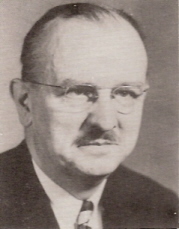
| LEO J. NOWICKI (former DSR General Manager) In 1953 Nowicki began his campaign to convert the entire DSR operation over to GM diesel buses. |
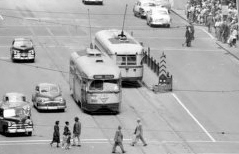
| The DSR argued that the use of center of the road loading platforms or safety zones (like the one pictured above), subjected passengers to the constant dangers of vehicular traffic. |
to the hazards of vehicular traffic because of the center-of-street loading
required with the operation of streetcars. This exposure to street traffic
would be greatly reduced with the curb loading and unloading provided with
the use of buses or "trackless" trolley-coaches. It was also stated that the
conversion from streetcars to buses, and the subsequent removal of those
unsafe street loading zones, would also permit improvements in the speed
and flow of traffic by allowing for the development of left turn lanes and
reversible center lanes.
But despite the considerable opposition this bus substitution plan created
from the public and the press, the conversion over to diesel coaches was
approved by the Street Railway Commission and the Common Council.
After the arrival of 75 new GM model TDH-5105 "air-suspension" coaches
required with the operation of streetcars. This exposure to street traffic
would be greatly reduced with the curb loading and unloading provided with
the use of buses or "trackless" trolley-coaches. It was also stated that the
conversion from streetcars to buses, and the subsequent removal of those
unsafe street loading zones, would also permit improvements in the speed
and flow of traffic by allowing for the development of left turn lanes and
reversible center lanes.
But despite the considerable opposition this bus substitution plan created
from the public and the press, the conversion over to diesel coaches was
approved by the Street Railway Commission and the Common Council.
After the arrival of 75 new GM model TDH-5105 "air-suspension" coaches
| The arrival in August, 1955 of 30 GM diesel coaches (including coach #1320 in photo), enabled the DSR to substitute buses for streetcars on Michigan Avenue on September 7, 1955. |
Information for the above article was compiled from various articles written by Jack E. Schramm on the Detroit Street Railways, including "Detroit's DSR. Part 3"
(Motor Coach Age - May-June 1993), and "DETROIT'S STREET RAILWAYS Vol II: City Lines 1922-1956" (Bulletin 120 - Central Electric Railfans' Association),
and from numerous Detroit Free Press and Detroit News newspaper articles supplied by Ken Schramm, and from the Stanley Sycko Collection.
Virtual Motor City Collection photo #48414 used by permission of the Walter P. Reuther Library, Wayne State University.
All rights, including those of further reproduction and/or publication, are reserved in full by the Walter P. Reuther Library, Wayne State University. Photographic
reproductions may be protected by U.S. copyright law (U.S. Title 17). The user is fully responsible for copyright infringement.
(Motor Coach Age - May-June 1993), and "DETROIT'S STREET RAILWAYS Vol II: City Lines 1922-1956" (Bulletin 120 - Central Electric Railfans' Association),
and from numerous Detroit Free Press and Detroit News newspaper articles supplied by Ken Schramm, and from the Stanley Sycko Collection.
Virtual Motor City Collection photo #48414 used by permission of the Walter P. Reuther Library, Wayne State University.
All rights, including those of further reproduction and/or publication, are reserved in full by the Walter P. Reuther Library, Wayne State University. Photographic
reproductions may be protected by U.S. copyright law (U.S. Title 17). The user is fully responsible for copyright infringement.
© 2007 (PAGE LAST MODIFIED ON 08-02-07, 01-12-14)
| (Walter P. Reuther Library, Wayne State University photo #48414 — used with permission) |
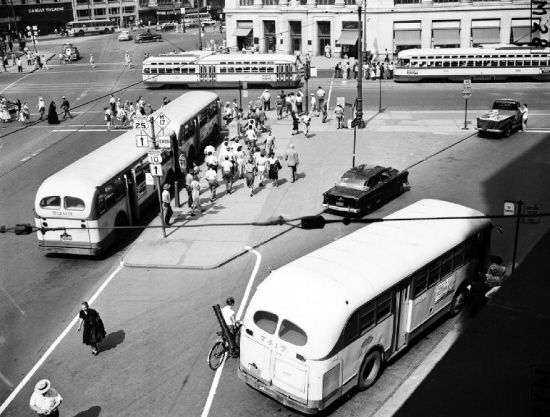
| TO VIEW INTERIOR PCC PHOTOS CLICK: INSIDE LOOK |
| . |
| During the Annual Labor Day Parade along Woodward Ave., the DSR would use shuttle buses to continue downtown, while Woodward PCCs would short-turn at Warren Avenue. In this 1954 photo, taken at the intersection of Woodward and Warren Avenues, both PCC streetcars and new General Motors diesel buses can be seen operating along-side each other during the parade. By 1954, the DSR would have had 100 of these GM (model TDH-5105) diesels already in its bus fleet. Within two years, additional fleets of GM diesel coaches would have replaced these very same PCC cars. |
| Passenger safety was one of the selling points used by DSR management to justify eliminating the last of the city's railway fleet. This June, 1954 photo looks east along Fort Street at Woodward Ave., back when the former 10-story Hammond Building (shadow only visible in photo) occupied the south-west corner of that intersection. DSR buses, along with a PCC car, can be seen loading or unloading passengers. While the PCC seen traveling northbound along Woodward must board its passengers within the center of the roadway, the motor buses along Fort Street can offer curb-side service. |
| |||||||

| Detroit's first PCC line to undergo bus substitution was the Jefferson line— the city's first horse-drawn rail line back in 1863. In this photo, car #197 can be seen at the Wayburn Loop, which is located just to the east of the city limits in the city of Grosse Pointe Park. The Wayburn Loop property was originally purchased by the former DUR Company back on October 24, 1910, and still serves as the terminus for the Jefferson bus line to this day. (photo courtesy of the Krambles-Peterson archive collection: C. Foreman photo) |



| .. |
| Preserving the History of Public Transportation in and around the City of Detroit, ...from "Steel Wheels to Rubber Tires." |
